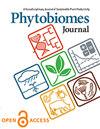CRISPR/Cas9-Mediated Mutagenesis of Carotenoid Cleavage Dioxygenase (CCD) Genes in Sorghum Alters Strigolactone Biosynthesis and Plant Biotic Interactions
IF 2.6
3区 生物学
Q2 MICROBIOLOGY
引用次数: 2
Abstract
Strigolactones are a group of small molecules that play critical roles in plant developmental processes and root biotic interactions. Strigolactones are agronomically important due to their role as a signal for the germination of a parasitic weed ( Striga spp.) that reduces yields of cereal crops worldwide. To identify the genes encoding strigolactones in sorghum and their function, we characterized two CRISPR/Cas9-mediated gene knockouts of carotenoid cleavage dioxygenase 8 ( CCD8) genes ( SbCCD8a and SbCCD8b), which have been shown in other plant species to be involved in strigolactone biosynthesis. Although strigolactones are important for the parasitization of sorghum in Africa, the functions of members of the CCD8 family have not been characterized. The impact of the knockouts on strigolactone production, plant growth and development, resistance to the parasitic weed Striga, and the root-associated microbiomes were investigated in this study. The results revealed that knockout of SbCCD8 genes in sorghum significantly reduced orobanchol production and Striga germination. Strigolactone deficiency altered the shoot and root architecture and reduced grain yield of sorghum. The knockout of the SbCCD8b gene significantly affected the rhizosphere bacterial diversity and community composition at sorghum plant grain-fill stage due to the abolition of orobanchol exudation from roots. Reduced amounts of orobanchol in root exudates also influenced root-associated fungal taxa abundance. Our findings provide new insights into potentially sustainable approaches for the recruitment of beneficial microbes and for parasitic weed control through manipulation of strigolactone production in sorghum.CRISPR/ cas9介导的高粱类胡萝卜素裂解双加氧酶(CCD)基因突变改变独角麦内酯生物合成和植物生物相互作用
独角糖内酯是一类在植物发育过程和根系生物相互作用中起重要作用的小分子。独角曲内酯具有重要的农学意义,因为它们是一种寄生杂草(Striga spp.)发芽的信号,这种杂草会降低全世界谷类作物的产量。为了鉴定高粱中编码独脚金内酯的基因及其功能,我们鉴定了CRISPR/ cas9介导的类胡萝卜素裂解双加氧酶8 (CCD8)基因的两个基因敲除(SbCCD8a和SbCCD8b),这两个基因在其他植物物种中已被证明参与独脚金内酯的生物合成。尽管独角金内酯对非洲高粱的寄生很重要,但CCD8家族成员的功能尚未被表征。本研究探讨了基因敲除对独脚金内酯生产、植物生长发育、对寄生杂草Striga的抗性以及根相关微生物组的影响。结果表明,敲除高粱中SbCCD8基因可显著降低凤尾鱼产量和斯曲加菌的萌发。独角麦内酯缺乏改变了高粱的茎和根构型,降低了籽粒产量。SbCCD8b基因敲除显著影响了高粱植株灌浆期根际细菌多样性和群落组成,这主要是由于根茎中溴凤尾鱼分泌量的减少。根分泌物中溴凤尾鱼含量的减少也影响了根相关真菌分类群的丰度。我们的研究结果为潜在的可持续方法提供了新的见解,通过操纵高粱的独角麦内酯生产来招募有益微生物和控制寄生杂草。
本文章由计算机程序翻译,如有差异,请以英文原文为准。
求助全文
约1分钟内获得全文
求助全文

 求助内容:
求助内容: 应助结果提醒方式:
应助结果提醒方式:


